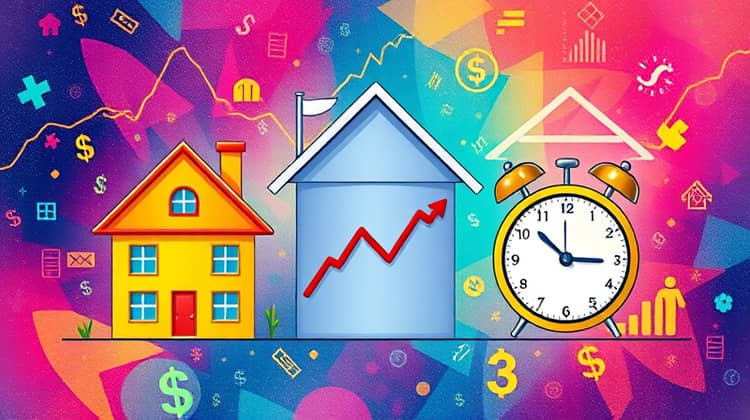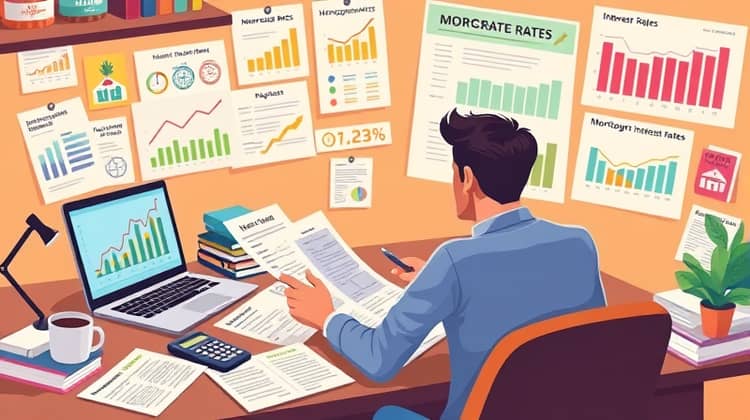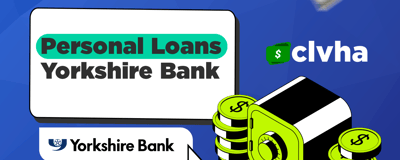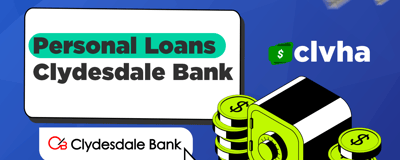Understanding mortgage loans can seem overwhelming at first, but breaking it down into manageable steps can make the process smoother. This guide is designed to walk you through each phase of obtaining a mortgage, from assessing your financial situation to closing on your home. With the right knowledge, you can confidently navigate this journey and secure the best deal for your circumstances.
Mortgage loans are a fundamental aspect of the home-buying process, allowing individuals and families to finance their dreams of homeownership. With various options available, it’s crucial to comprehend the specific requirements and implications of each to make an informed decision. This guide aims to demystify mortgages, explaining each step along the way with clarity and precision.
Many factors will influence your mortgage choices, including your financial health, credit score, and personal preferences. By understanding these elements upfront, you can lay a solid foundation for successfully acquiring the financing you need for your new home. The ensuing sections are structured to offer you clarity on this often-complicated process.
Introduction

Before diving into the world of mortgages, it's essential to assess your current financial situation. This includes evaluating your income, other debts, and general economic standing. Knowing where you stand financially helps you determine how much you can afford to borrow and what type of mortgage may be best suited for your needs.
Additionally, understanding your financial situation will also help you prepare for the various costs associated with homeownership beyond the mortgage payments, such as property taxes, homeowner's insurance, and maintenance costs.
- Gather your income and expense statements.
- Check your credit score and report.
- Evaluate your debts and existing financial obligations.
Making an honest assessment of your finances will empower you to make informed decisions moving forward. Once you grasp your financial status, you're better prepared to explore mortgage options safely.
Step 1: Assess Your Financial Situation

Assessing your financial situation is a critical first step when considering a mortgage. It serves as the foundation for all future decisions concerning your home loan, allowing potential buyers to understand what they can afford without overstretching their finances.
A comprehensive view of your financial status will highlight your strengths and weaknesses, giving you a clearer picture of how much you should aim to borrow and what your monthly payments might look like.
Step 2: Understand the Types of Mortgage Loans

Understanding the various types of mortgage loans available is vital for anyone looking to buy a home. Each mortgage product has different terms, structures, and benefits, which can significantly impact your monthly payment and overall financial health.
By familiarizing yourself with the common types of loans, you can identify the one that best fits your circumstances and goals as a homebuyer.
- Fixed-rate mortgage
- Adjustable-rate mortgage (ARM)
- Interest-only mortgage
Each of these mortgage types offers distinct advantages and potential drawbacks. It's crucial to consider your financial situation and long-term plans when selecting the best mortgage option for you.
Fixed-Rate Mortgage
A fixed-rate mortgage is one of the most common types of home loans. This mortgage offers borrowers a stable interest rate for the entire life of the loan, typically 15 or 30 years.
The predictability of monthly payments makes budgeting easier, as homeowners do not have to worry about fluctuating interest rates affecting their payment amounts.
Adjustable-Rate Mortgage (ARM)
An adjustable-rate mortgage (ARM) features an interest rate that may change after an initial fixed period, typically 5, 7, or 10 years. Once this period ends, the rate adjusts based on market conditions, which can lead to lower initial monthly payments but also exposes borrowers to the risk of future rate increases.
If you plan to move or refinance before the adjustment period kicks in, an ARM may offer a lower cost initially. However, if you stay in the home long-term, be prepared for potential increases in your monthly payments.
Interest-Only Mortgage
Interest-only mortgages are another alternative for some borrowers. These loans allow homeowners to pay only the interest on the loan for a specified period, often resulting in lower initial monthly costs.
However, after the interest-only period ends, borrowers must start repaying both the principal and interest, leading to significantly higher payments down the line.
Step 3: Improve Your Credit Score

A good credit score is a crucial element in qualifying for a mortgage with favorable terms. Lenders use your credit score to assess your reliability as a borrower. A higher score translates to lower interest rates and better loan options.
Improving your credit score requires time and effort but can pay off significantly when it comes to your mortgage.
- Check your credit report for errors and dispute inaccuracies.
- Pay down outstanding debts to lower your credit utilization ratio.
- Make all payments (credit cards, loans, etc.) on time.
By proactively managing your credit score, you can increase your chances of securing a better mortgage rate, which can save you thousands over the life of the loan.
Step 4: Save for a Down Payment

Saving for a down payment is another significant step in the home-buying process. While many lenders recommend a 20% down payment, there are options available for those who can put down less.
Having a substantial down payment can lower your monthly mortgage cost and avoid private mortgage insurance (PMI), which protects lenders if borrowers default on the loan.
- Set a specific savings goal based on your desired home price.
- Create a budget that includes a savings plan.
- Consider opening a dedicated savings account for your down payment.
Taking steps to save for your down payment will help you be better prepared when it’s time to make an offer on a home.
Step 5: Get Pre-Approved

Getting pre-approved for a mortgage helps establish how much you can borrow, providing a clear picture of your budget when home shopping. This process involves a lender evaluating your financial background, including credit score, income, and debts.
Receiving pre-approval makes you a more attractive buyer since it shows sellers you are serious and capable of following through with financing. This can give you an advantage in competitive markets.
Step 6: Shop for a Mortgage

With your pre-approval in hand, you can confidently start shopping for a mortgage. Compare offers from various lenders to secure the best interest rate and terms for your situation.
Do not hesitate to negotiate terms and ask lenders about any fees associated with the loan.
- Gather quotes from multiple lenders.
- Compare interest rates and terms carefully.
- Look at the overall cost of the mortgage including fees.
By comparing various mortgage offers, you can save a considerable amount of money over the life of the loan.
Step 7: Understand Closing Costs

Closing costs are fees associated with finalizing your mortgage and purchasing your home. These can range from 2% to 5% of the loan amount and include various fees such as application fees, appraisal fees, and title insurance.
Being aware of these costs will help you budget for the total expense of your home purchase, beyond just the down payment.
Step 8: Complete the Application Process

Completing the application process involves submitting a variety of financial documents and information to your lender. This typically includes proof of income, tax returns, bank statements, and details about any debts you currently have.
Once your application is complete, your lender will process it, requiring you to stay engaged and responsive to any requests for additional information or documentation.
Step 9: Loan Underwriting

After your application is submitted, it moves into the underwriting stage, where the lender’s underwriter will assess your financial profile and the property details to determine whether to approve your loan. Additionally, they will need to verify your financial documents, which might include rechecking credit scores and financial standings, along with property appraisals.
It's crucial to respond quickly and provide any required information during this phase to keep the process moving smoothly.
- Review the underwriter's requirements and fulfill them promptly.
- Stay in communication with your lender during this stage.
- Be prepared to explain any inconsistencies in your financial documentation.
Ensuring that you understand and meet the underwriting requirements is key to moving forward without delays or complications.
Step 10: Closing Day

Closing day is the final step in the mortgage process, where the property officially transfers ownership from the seller to the buyer. This day typically involves signing numerous documents that finalize the mortgage agreement and transfer the title of the property.
Before closing, ensure that you have reviewed all documents and understand updated costs so that there are no surprises on closing day.
- Review and finalize the closing disclosure for accuracy.
- Bring all required documentation and payment for closing costs.
- Prepare for a final walkthrough of the property before closing.
Successfully closing on your home signifies the culmination of your diligent preparation and commitment to homeownership.
Conclusion

The process of obtaining a mortgage can seem daunting, but by following these steps, you can approach it with confidence. The first step, assessing your financial situation, establishes a solid foundation for making informed decisions regarding your home purchase. By understanding the various types of mortgage loans and their implications, you'll be equipped to choose the option that best fits your needs.
Improving your credit score and saving for a down payment are essential components of securing favorable mortgage terms. Additionally, getting pre-approved, shopping for a mortgage, and understanding the associated costs rounds out the critical steps in preparing to buy a home.














